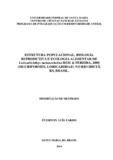| dc.creator | Zardo, Éverton Luís | |
| dc.date.accessioned | 2015-02-19 | |
| dc.date.available | 2015-02-19 | |
| dc.date.issued | 2014-02-17 | |
| dc.identifier.citation | ZARDO, Éverton Luís. Populational structure, reproductive biology and feeding ecology of Loricariichthys melanocheilus Reis & Pereira, 2000 (Siluriformes, Loricariidae) in Ibicui river, RS, Brazil. 2014. 80 f. Dissertação (Mestrado em Ciencias Biológicas) - Universidade Federal de Santa Maria, Santa Maria, 2014. | por |
| dc.identifier.uri | http://repositorio.ufsm.br/handle/1/5320 | |
| dc.description.abstract | The aim of this work was analyze population structure, reproductive biology and feeding ecology of Loricariichthys melanocheilus in Ibicui River. Fish were caught bimonthly in lotic and lentic environment between São Vicente do Sul and Itaqui, with gillnets and witches, with revision every six hours. The population structure was evaluated by seasonal and spatial distribution, bimonthly variations in average size, sex ratio and weight-length relationship. Females reached larger sizes than males and the sex ratio was 1.38 females per male, with some variations bimonthly. This species showed positive allometric growth, with greater increase in weight than in length during ontogenetic development. The condition factor was higher in males and in June/July. Females didn t show variations in this parameter. The values of gonad condition factor, GSI and the frequency of mature individuals indicate that the reproductive period begins in August/September, peaking in October / November and spawning in the following months. Regarding the feeding ecology, L. melanocheilus showed a detritivorous feeding habit, even consuming sediment, organic vegetable matter, nematodes, insects of the order Diptera, Trichoptera, Ephemeroptera and Odonata, algae, microcrustaceans, fungi, protozoa and other invertebrates. The diet showed little seasonal, environmental and by length classes variation. The species showed no intense feeding activity, being higher before or after the reproductive period and in lentic environment. The intestinal quotient of 1.51 was smaller than registered for other species of the family, showing variations according to the length classes in response to variations in the diet. | eng |
| dc.description.sponsorship | Coordenação de Aperfeiçoamento de Pessoal de Nível Superior | |
| dc.format | application/pdf | por |
| dc.language | por | por |
| dc.publisher | Universidade Federal de Santa Maria | por |
| dc.rights | Acesso Aberto | por |
| dc.subject | Atividade alimentar | por |
| dc.subject | Crescimento | por |
| dc.subject | Espectro trófico | por |
| dc.subject | Hábito alimentar | por |
| dc.subject | Período reprodutivo | por |
| dc.subject | Feeding activity | eng |
| dc.subject | Growth | eng |
| dc.subject | Trophic spectrum | eng |
| dc.subject | Feeding habits | eng |
| dc.subject | Reproductive period | eng |
| dc.title | Estrutura populacional, biologia reprodutiva e ecologia alimentar de Loricariichthys melanocheilus Reis & Pereira, 2000 (Siluriformes, Loricariidae) no rio Ibicuí, RS, Brasil | por |
| dc.title.alternative | Populational structure, reproductive biology and feeding ecology of Loricariichthys melanocheilus Reis & Pereira, 2000 (Siluriformes, Loricariidae) in Ibicui river, RS, Brazil | eng |
| dc.type | Dissertação | por |
| dc.description.resumo | O objetivo do presente trabalho foi avaliar aspectos da estrutura populacional, biologia reprodutiva e ecologia alimentar de Loricariichthys melanocheilus no rio Ibicuí. Os peixes foram coletados bimestralmente em ambientes lênticos e lóticos no rio Ibicuí, entre os municípios de São Vicente do Sul e Itaqui, utilizando redes de espera e feiticeiras, com revisão a cada seis horas no período de 24 horas. A estrutura populacional foi avaliada através da distribuição sazonal e espacial, das variações bimestrais nos tamanhos médios, proporção sexual total, bimestral e por classes de comprimento e relação peso/comprimento. As fêmeas atingiram tamanhos maiores que os machos e a proporção sexual encontrada foi de 1,38 fêmeas para cada macho, com algumas variações bimestrais. A espécie apresentou crescimento alométrico positivo, com maior incremento em peso do que em comprimento durante o desenvolvimento ontogênico. Os machos apresentaram maior fator de condição que as fêmeas, sendo mais elevado em junho/julho. Já as fêmeas não apresentaram variações neste índice durante o período de estudo. Os valores do fator de condição gonadal, índice gonadossomático e a frequência de indivíduos maduros indicam que o período reprodutivo da espécie se inicia em agosto/setembro, com pico em outubro/novembro e desova nos meses seguintes. Em relação à ecologia alimentar, L. melanocheilus apresentou hábito alimentar detritívoro, consumindo ainda sedimento, matéria orgânica vegetal, Nematoda, insetos das ordens Diptera, Trichoptera, Ephemeroptera e Odonata, algas, microcrustáceos, fungos, protozoários e outros invertebrados. A dieta apresentou poucas variações sazonais, ambientais e por classes de comprimento. A espécie não apresentou atividade alimentar intensa, sendo esta mais elevada em períodos anteriores ou posteriores ao período reprodutivo e em ambientes lênticos. O quociente intestinal de 1,51 foi menor do que registrado para outras espécies da família e apresentou variações sazonais e de acordo com as classes de comprimento, em resposta às variações na dieta. | por |
| dc.contributor.advisor1 | Behr, Everton Rodolfo | |
| dc.contributor.advisor1Lattes | http://lattes.cnpq.br/5793290654126265 | por |
| dc.contributor.referee1 | Fialho, Clarice Bernhardt | |
| dc.contributor.referee1Lattes | http://lattes.cnpq.br/5124669349178784 | por |
| dc.contributor.referee2 | Ferreira, Francesca Werner | |
| dc.contributor.referee2Lattes | http://lattes.cnpq.br/1926373598285118 | por |
| dc.creator.Lattes | http://lattes.cnpq.br/5338575935207824 | por |
| dc.publisher.country | BR | por |
| dc.publisher.department | Ciências Biológicas | por |
| dc.publisher.initials | UFSM | por |
| dc.publisher.program | Programa de Pós-Graduação em Biodiversidade Animal | por |
| dc.subject.cnpq | CNPQ::CIENCIAS BIOLOGICAS | por |


